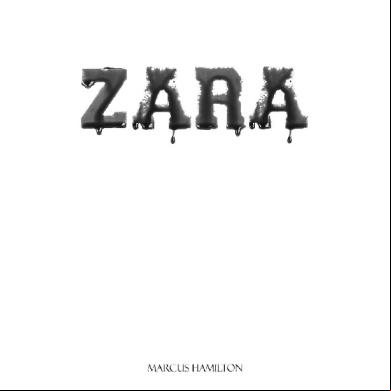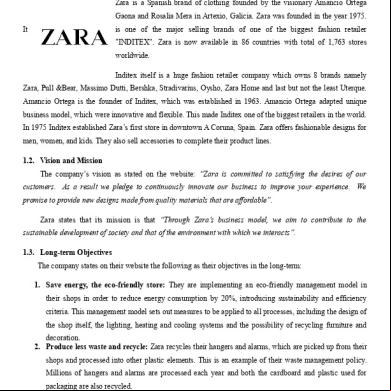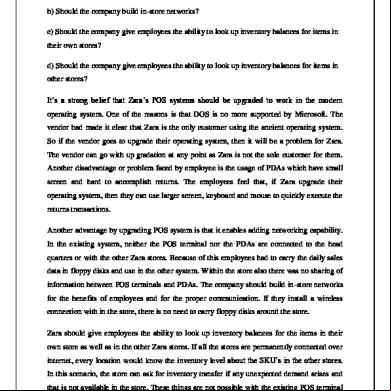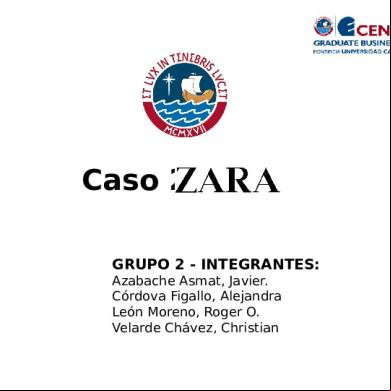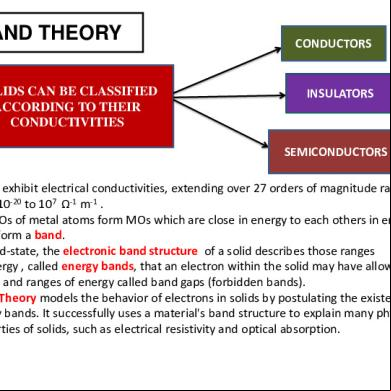Zara 371313
This document was ed by and they confirmed that they have the permission to share it. If you are author or own the copyright of this book, please report to us by using this report form. Report 3b7i
Overview 3e4r5l
& View Zara as PDF for free.
More details w3441
- Words: 1,483
- Pages: 8
2|Page
Apparel Industry: An overview The apparel industry is typically a buyer driven industry with highly fragmented production. The production process is labour intensive which has resulted in the emergence of developing countries as key producers due to the availability of cheap labour. As of 2000, the market size estimate was approximately €900 billion worldwide. The industry is characterized by significant local variation in customer attributes and preferences and thus a high level of uncertainty in demand. Refer to Exhibit 1 for Porter’s five forces analysis on the Apparel industry. The industry can be labelled as moderate in of attractiveness with a superior buyer power and low supplier power. But at the same time, it can be characterised with intense competition. Threat of substitution can be termed as high in view of rapidly changing fashion and customer preferences.
CASE About Inditex ANALY ZARA: FAST FASHION Inditex is a global specialty retailer with total revenue of €3,250 million as SIS of 2001. It designs, manufactures and sells apparel, footwear and accessories for women, men and children through six chains including Zara. It is headquartered in Galicia, Spain.
About Zara As of 2001, Zara was the largest and the most internationalized among the six chains of Inditex. It contributed approximately 76% of the total sales of Inditex. It was rolled out in the Spanish market in 1990.
Key competencies of Zara Compared to its competitors, Zara maintained smaller lead time to roll out new products. Case facts mention that it took only four to five weeks for Zara to originate a design and have finished goods in stores for entirely new
SUBMITTED BY: Group 2J Arit Kumar Mondal Nirupam Das Rajarshi Sarma
New product roll-out time
3|Page
designs. Traditional industry model involved typically up to six months for design and three months for manufacturing. The implication of this could be observed in the fact that three quarters of the merchandize on display was changed every three to four weeks, increasing average time between visits for customers. An estimate shows that the average Zara shopper visited the chain 17 times a year compared to three to four times a year for competing chains. This results in a significant increase in revenue for the chain.
Effective vertical integration In contrast to the prevailing industry practice of out-sourcing most of the operations (100% for H&M, more than 90% for GAP), Zara manufactured about 40% of the products internally. They outsourced the products depending on the demand characteristics. For example, the most fashionable items that were supposed to be the riskiest were produced in house in small batches so that further demand could be met by observing the initial performance. Also, products that were more price sensitive than time sensitive were outsourced to Asia to exploit the cheaper labour. This kind of strategy had two major implications. In the first place, they could maintain a very small lead time of production. Also, they could counter the uncertainty caused by Bull-whip effect due to longer supply chain. In spite of this structure, they maintained a manageable cap on the expenditure. World Co. of Japan, which followed a similar structure, incurred 40% of its revenue in selling, istrative and general expenses, whereas the similar figure for Zara was only 20%.
Lead time of production Due to vertical integration, Zara maintained a short lead time of production. It reduced the working capital intensity and at the same time, enabled them to cope with the seasonality in demand. According to case data, Zara undertook 35% of product design and purchase of raw material, 40-50% of the purchases of finished products from external suppliers, 85% of the in-house production after the season has started, against a mere 0-20% for the traditional retailers. It gave them a competitive edge while facing seasonal uncertainty in demand.
Positioning of Zara From inception, Zara positioned itself as selling “medium quality fashion clothing at affordable prices”. This is perfectly in coherence with the consumer behaviour in Spain. Traditionally, Spanish consumers are known to be price sensitive and not very keen on highly discriminating or 4|Page
fashionable products. It can be inferred that the ability of the chain to understand consumer behaviour must have accelerated its growth in the initial phases.
Marketing strategy Zara followed a non-traditional way of advertising. It emphasises more on store displays rather than brand building through media advertising. As mentioned in the case, they spent only 0.3% of its revenue in media advertising, compared to 3-4% for most specialty retailers. They rather focused on the freshness of their offering to attract customers, creating an attractive ambience around them and thus creating a positive word of mouth. This non-traditional way of advertising was quite effective in that the average number of Zara customers visiting a shop in a year far exceeding the same in competing chains.
Ability to cope with changing fashion Zara continuously tracked customer preferences and sales potential based on a consumer information system that ed detailed analysis of product life cycles. This was supplemented by the shorter lead time of production to cater to the changing customer preferences. This enabled Zara to overcome the potential threat of “fashion miss” faced by the leading competitors like Gap and H&M.
Extensive use of Technology From its inception, high end technologies have always been a key differentiator for Zara from its competing chains. They had implemented just in time manufacturing to their production facilities to obtain higher yields. Also, they had advanced telecommunication system to connect headquarters and supply, production and sales locations. This was vital in the chain’s ability to maintain short lead time of production as well as to keep track of the changing consumer preferences.
Key Challenges Need for Aggressive Growth Strategy As of 2001, 76% of Inditex’s stock value was based on future growth expectations. Also a 15% growth rate of selling space was a necessity. The European market was nearing saturation. Hence, Zara had to explore other untapped markets. 5|Page
Sustained Competitive Advantage in New Markets In order to be ahead of its competitors, Zara has to incorporate its European business model of Quick Response System in the new markets of USA, Japan, Middle-East & Asia. The main challenges are as follows: ✔ Poor supply chain strategy: Zara won’t be able to leverage its
greatest strength of variety & short lead times due to single central distribution centre model. ✔ Diseconomies of Scale: The centralised distribution centre in Europe is the main reason. Zara would be subjected to diseconomies of scale if it plans to enter new markets but manages its logistics from a single distribution centre.
High New Product Development Costs Zara’s designers used to attend fashion events & trade fairs to incorporate the latest seasonal trends into their designs. In order to understand customer preferences, Zara used to constantly research the market by placing trend spotters in clubs, discotheques and university campuses. This incurred huge expenditure for Zara.
Recommendations Distribution centre in USA The competitive advantage of Zara is its Quick Response system to varying consumer demands. In order to achieve an annual growth of 15% of its selling space, Zara has to enter the potential US market and thus incorporate its business model. A central distribution centre in the USA would help Zara reduce its logistic expenses and also maintain short lead times.
Small distribution centre in Non-European countries Zara can consider opening up of satellite distribution centres in regions like the Middle East, Japan & South East Asia. This can further reduce its logistics costs rather than maintaining the same from its European distribution centre.
6|Page
E-Retailing Customers can be reached easily in the countries Zara is trying to expand its operations. It can also help to understand customer preferences & market trends.
SWOT ANALYSIS Refer to Exhibit 2 for the SWOT analysis of Zara Fashion. Zara would be subjected to intense price competition after the Quota Elimination of 2005. The number of competitors (both local & international) would increase manifold thereby increasing the competition among firms.
VRIN FRAMEWORK Refer to Exhibit 3 for the VRIN framework analysis of Zara Fashion. Valuable: Zara’s resources & capabilities which enable it to respond to environmental threats. Rare: The particular resource is only controlled by a few competing firms. Imitability: Difficult to imitate the particular resource by the competitors. (Cost disadvantage to competing firms) Non-substitutability: The resource is difficult to be substituted by some other resource Conclusion: From the analysis of VRIN framework, it can be concluded that Zara Fashion has temporary competitive advantage.
7|Page
Exhibits EXHIBIT 1: Porter’s Five Force Analysis
EXHIBIT 2: SWOT ANALYSIS OF ZARA FASHION
EXHIBIT 3: VRIN FRAMEWORK FOR ZARA FASHION
Valuabl e
Rar e
Imitability
NonSubstitutability
Short Lead Time
Y
Y
Y
N
Quick Response System
Y
Y
Y
N
High Design Variety
Y
Y
N
N
High End Technology
Y
Y
Y
N
High Inventory Turnover
Y
Y
Y
N
Resources
8|Page
Apparel Industry: An overview The apparel industry is typically a buyer driven industry with highly fragmented production. The production process is labour intensive which has resulted in the emergence of developing countries as key producers due to the availability of cheap labour. As of 2000, the market size estimate was approximately €900 billion worldwide. The industry is characterized by significant local variation in customer attributes and preferences and thus a high level of uncertainty in demand. Refer to Exhibit 1 for Porter’s five forces analysis on the Apparel industry. The industry can be labelled as moderate in of attractiveness with a superior buyer power and low supplier power. But at the same time, it can be characterised with intense competition. Threat of substitution can be termed as high in view of rapidly changing fashion and customer preferences.
CASE About Inditex ANALY ZARA: FAST FASHION Inditex is a global specialty retailer with total revenue of €3,250 million as SIS of 2001. It designs, manufactures and sells apparel, footwear and accessories for women, men and children through six chains including Zara. It is headquartered in Galicia, Spain.
About Zara As of 2001, Zara was the largest and the most internationalized among the six chains of Inditex. It contributed approximately 76% of the total sales of Inditex. It was rolled out in the Spanish market in 1990.
Key competencies of Zara Compared to its competitors, Zara maintained smaller lead time to roll out new products. Case facts mention that it took only four to five weeks for Zara to originate a design and have finished goods in stores for entirely new
SUBMITTED BY: Group 2J Arit Kumar Mondal Nirupam Das Rajarshi Sarma
New product roll-out time
3|Page
designs. Traditional industry model involved typically up to six months for design and three months for manufacturing. The implication of this could be observed in the fact that three quarters of the merchandize on display was changed every three to four weeks, increasing average time between visits for customers. An estimate shows that the average Zara shopper visited the chain 17 times a year compared to three to four times a year for competing chains. This results in a significant increase in revenue for the chain.
Effective vertical integration In contrast to the prevailing industry practice of out-sourcing most of the operations (100% for H&M, more than 90% for GAP), Zara manufactured about 40% of the products internally. They outsourced the products depending on the demand characteristics. For example, the most fashionable items that were supposed to be the riskiest were produced in house in small batches so that further demand could be met by observing the initial performance. Also, products that were more price sensitive than time sensitive were outsourced to Asia to exploit the cheaper labour. This kind of strategy had two major implications. In the first place, they could maintain a very small lead time of production. Also, they could counter the uncertainty caused by Bull-whip effect due to longer supply chain. In spite of this structure, they maintained a manageable cap on the expenditure. World Co. of Japan, which followed a similar structure, incurred 40% of its revenue in selling, istrative and general expenses, whereas the similar figure for Zara was only 20%.
Lead time of production Due to vertical integration, Zara maintained a short lead time of production. It reduced the working capital intensity and at the same time, enabled them to cope with the seasonality in demand. According to case data, Zara undertook 35% of product design and purchase of raw material, 40-50% of the purchases of finished products from external suppliers, 85% of the in-house production after the season has started, against a mere 0-20% for the traditional retailers. It gave them a competitive edge while facing seasonal uncertainty in demand.
Positioning of Zara From inception, Zara positioned itself as selling “medium quality fashion clothing at affordable prices”. This is perfectly in coherence with the consumer behaviour in Spain. Traditionally, Spanish consumers are known to be price sensitive and not very keen on highly discriminating or 4|Page
fashionable products. It can be inferred that the ability of the chain to understand consumer behaviour must have accelerated its growth in the initial phases.
Marketing strategy Zara followed a non-traditional way of advertising. It emphasises more on store displays rather than brand building through media advertising. As mentioned in the case, they spent only 0.3% of its revenue in media advertising, compared to 3-4% for most specialty retailers. They rather focused on the freshness of their offering to attract customers, creating an attractive ambience around them and thus creating a positive word of mouth. This non-traditional way of advertising was quite effective in that the average number of Zara customers visiting a shop in a year far exceeding the same in competing chains.
Ability to cope with changing fashion Zara continuously tracked customer preferences and sales potential based on a consumer information system that ed detailed analysis of product life cycles. This was supplemented by the shorter lead time of production to cater to the changing customer preferences. This enabled Zara to overcome the potential threat of “fashion miss” faced by the leading competitors like Gap and H&M.
Extensive use of Technology From its inception, high end technologies have always been a key differentiator for Zara from its competing chains. They had implemented just in time manufacturing to their production facilities to obtain higher yields. Also, they had advanced telecommunication system to connect headquarters and supply, production and sales locations. This was vital in the chain’s ability to maintain short lead time of production as well as to keep track of the changing consumer preferences.
Key Challenges Need for Aggressive Growth Strategy As of 2001, 76% of Inditex’s stock value was based on future growth expectations. Also a 15% growth rate of selling space was a necessity. The European market was nearing saturation. Hence, Zara had to explore other untapped markets. 5|Page
Sustained Competitive Advantage in New Markets In order to be ahead of its competitors, Zara has to incorporate its European business model of Quick Response System in the new markets of USA, Japan, Middle-East & Asia. The main challenges are as follows: ✔ Poor supply chain strategy: Zara won’t be able to leverage its
greatest strength of variety & short lead times due to single central distribution centre model. ✔ Diseconomies of Scale: The centralised distribution centre in Europe is the main reason. Zara would be subjected to diseconomies of scale if it plans to enter new markets but manages its logistics from a single distribution centre.
High New Product Development Costs Zara’s designers used to attend fashion events & trade fairs to incorporate the latest seasonal trends into their designs. In order to understand customer preferences, Zara used to constantly research the market by placing trend spotters in clubs, discotheques and university campuses. This incurred huge expenditure for Zara.
Recommendations Distribution centre in USA The competitive advantage of Zara is its Quick Response system to varying consumer demands. In order to achieve an annual growth of 15% of its selling space, Zara has to enter the potential US market and thus incorporate its business model. A central distribution centre in the USA would help Zara reduce its logistic expenses and also maintain short lead times.
Small distribution centre in Non-European countries Zara can consider opening up of satellite distribution centres in regions like the Middle East, Japan & South East Asia. This can further reduce its logistics costs rather than maintaining the same from its European distribution centre.
6|Page
E-Retailing Customers can be reached easily in the countries Zara is trying to expand its operations. It can also help to understand customer preferences & market trends.
SWOT ANALYSIS Refer to Exhibit 2 for the SWOT analysis of Zara Fashion. Zara would be subjected to intense price competition after the Quota Elimination of 2005. The number of competitors (both local & international) would increase manifold thereby increasing the competition among firms.
VRIN FRAMEWORK Refer to Exhibit 3 for the VRIN framework analysis of Zara Fashion. Valuable: Zara’s resources & capabilities which enable it to respond to environmental threats. Rare: The particular resource is only controlled by a few competing firms. Imitability: Difficult to imitate the particular resource by the competitors. (Cost disadvantage to competing firms) Non-substitutability: The resource is difficult to be substituted by some other resource Conclusion: From the analysis of VRIN framework, it can be concluded that Zara Fashion has temporary competitive advantage.
7|Page
Exhibits EXHIBIT 1: Porter’s Five Force Analysis
EXHIBIT 2: SWOT ANALYSIS OF ZARA FASHION
EXHIBIT 3: VRIN FRAMEWORK FOR ZARA FASHION
Valuabl e
Rar e
Imitability
NonSubstitutability
Short Lead Time
Y
Y
Y
N
Quick Response System
Y
Y
Y
N
High Design Variety
Y
Y
N
N
High End Technology
Y
Y
Y
N
High Inventory Turnover
Y
Y
Y
N
Resources
8|Page
